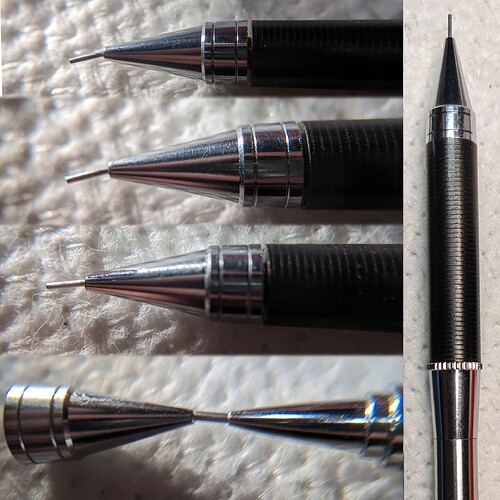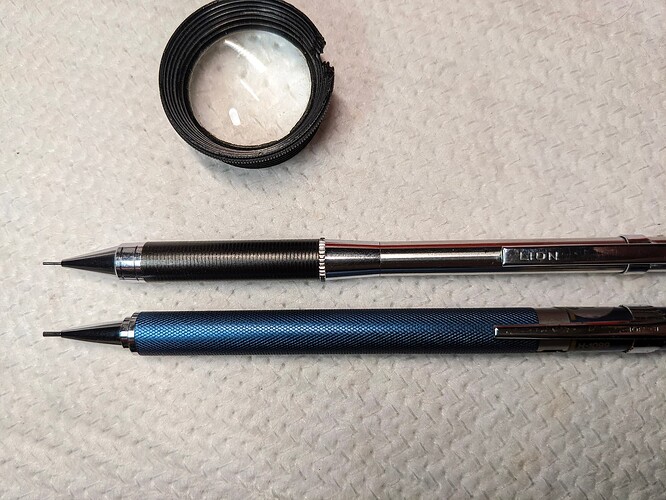I’d seen numerous posts about the rOtring 600 being dropped by someone who then cried out on Reddit about the lead pipe guide being bent… and asking if there was any way to fix it. The RR600 (for short) is probably the most well known (notoriously) for suffering bent lead pipe guides. Mainly it’s because of the weight of the pencil… and a 0.5 mm ID pipe is just not sturdy enough to survive bending from a weighty impact. The 0.35 mm is even worse! I’ve never dropped a RR600 on a hard floor. A few inches on a desk, but never did the pipe make contact.
Preamble out of the way… I had just gotten a LION 3430. Just a few minutes after being examined from the package, it was tucked back into the soft vinyl sleeve that it came in. There was no reinforced protection for the tip. And my mind wasn’t thinking of tip vulnerability. For a 0.3 mm pencil, the 3430 is a bit heavy. Almost rOtring style heavy. Despite that protective sleeve, the tip made impact as the pencil accidentally slipped from my fingers to the hard floor just between my feet. I could see through the sleeve that it was bent. Oh, so painful. Such a rare pencil too. Hefty pirate groaning. Arrrrrrrrrrrrrrrrrrrrrgh!
I figured, there’s one good person to talk to about this. I pinged Kelvin and told him what happened. In just a few words, he told me this: Use a 0.9 mm pencil to bend it back. Well, brilliant! My original plan was to set up a raised hard surface with a smooth sharp edge then holding the pencil steady, apply pressure on the pipe after determining the bend vector. But using the 0.9 mm nose cone is a better way to go.
- Using a loupe, examined the pipe closely, finding the view that has it seen as straight. This is looking direct down on the bend. The vector to unbend would be pointing back at me. I marked the nose cone with a Sharpie for ease of spotting orientation.
- I took off the 0.9 mm nose cone, donated from a PILOT H-1099. It slid nicely onto the 0.3 mm pipe with a little “wiggle room.” Letting go, gravity did the rest to confirm orientation. I then used my fingers to apply gentle pressure a couple of times. I then removed the 0.9 mm nose cone and examined it. There was some change. I kept repeating this.
- After about 8 cycles, I then reattached the H-1099 nose cone and carefully applied a little more pressure. Another check with a loupe and it looked pretty straight. I then gave one more push for good measure.
- I cleared the 0.3 mm pipe of the lead inside it using a wire. I then fed more lead forward through the pencil, then gently lowered the nose cone onto it. It moved smoothly. Screwed on, I then pressed the rear plunger and witnessed smooth lead advancement operation as before. A closeup didn’t show any new scoring to the lead… so alignment was confirmed. FIXED!
Just a couple of notes:
- Why 0.9 mm and not 0.7 mm? I think an 0.7 mm might work, but I felt like 0.9 mm was safer. I just didn’t want to chance accidentally bending a good lead pipe guide! The one on the H-1099 is very sturdy. No worries at all.
- It’s always best to take this slow. Don’t get anxious and try to get it done fast.
- My biggest concern wasn’t bending in the wrong direction, as I felt I solved that with this technique described above. The issue for me was bending too far. I really didn’t want to end up bending the pipe back and forth. Doing so could really weaken it and make it more prone to bending again.
- Now I can really appreciate why Pentel created that mechanical protective cylinder mechanism for the Mechanica. It’s fool proof!
- Never take your 0.3 mm pencils for granted in terms of being sturdy. It’s best to get some kind of hard plastic cylindrical sleeve to help protect it when not in use.

